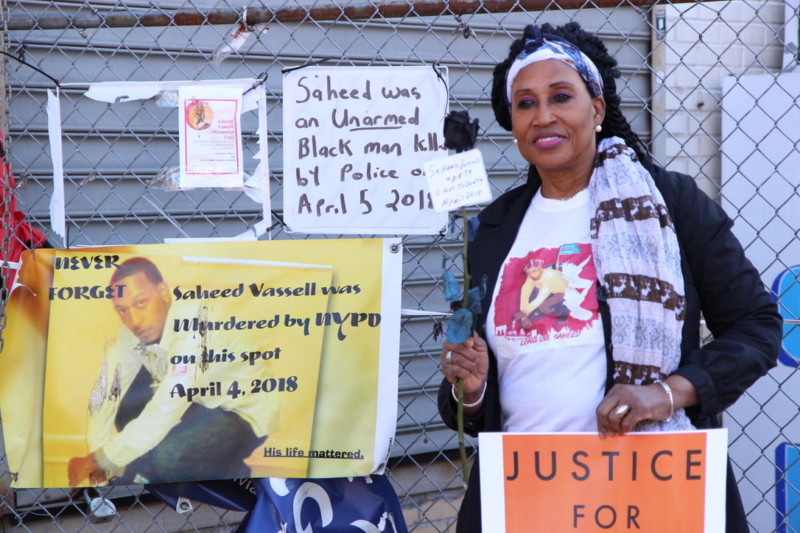Sign up for the daily CJR newsletter.
On April 4th, 2019, around 4pm, a crowd gathered on the corner of Utica Avenue and Montgomery Street in the Crown Heights neighborhood of Brooklyn. The weather was sunny and warm. The group had come for a memorial event: a year earlier, Saheed Vassell, a thirty-four-year-old Black man, had been shot and killed by a group of police officers: Leon Dinham, Anthony Bottiglieri, Bekim Molic, and Omar Rafiq. It was here that Vassell took his last breath. People held orange signs that read “Justice For Saheed”; across the street, friends gathered outside the barbershop where he used to work. They played music, danced, and celebrated his life. Lorna and Eric Vassell, Saheed’s parents, were there. The memorial had another purpose, too—as a protest against a decision that had just been made, by Letitia James, New York’s attorney general, not to seek criminal charges against the officers who killed Vassell.
In the two years since he died, so many Black people have lost their lives to police brutality that it can be hard to keep track of the names. Some are engraved into the national consciousness: Freddie Gray, Philando Castile, Sandra Bland, Oscar Grant, Mike Brown, and now Breonna Taylor, Tony McDade, and George Floyd. But others go unknown outside of their communities. Maybe these fatal encounters occur so often that even when the press covers a story, the next case has already appeared, overtaking our attention. According to data from Mapping Police Violence, a research collaborative, police killed three people per day in 2019, totaling nearly 1,100 killings. Twenty-four percent of those killed were Black, despite Black people making up only thirteen percent of the population. Each time, reporters have struggled to catch up; sometimes they didn’t.
Vassell, a local fixture, who moved from Jamaica to Crown Heights at the age of six, was one of the stories that passed most people by. The neighborhood in which he lived is home to a vibrant West Indian community. Eric Vassell became a deacon of the Brooklyn Community Church, which Saheed visited every morning at 5am. Saheed attended Apex Technical School, in nearby Long Island City. “Saheed was a welder,” Eric told me. “He was fascinated with iron, so whenever he walked out on the street he would pick up stray metal objects.” In 2008, after two of his closest friends died—one in a car crash, the other at the hands of police—Saheed began to struggle with his mental health. “We realized that he was acting different, saying different things, and ending up at the hospital where they diagnosed him with bipolar disorder,” Eric said.

Lorna Vassell at a memorial event and protest for her son, Saheed, who was shot and killed by police. Photo by Akintunde Ahmad.
People in Crown Heights knew Vassell to be mentally unstable, but harmless. “He is well known to everybody,” Kevin Davis, who runs the barbershop where Saheed worked, told me. “Nobody would have anything bad to say about him.” He went on, “If you had a conversation with him, you would be surprised to know what he knows. Just sometimes he would get in his head and be in his own little world.” Even the cops were acquainted with Vassell. “The police in the neighborhood got along with Saheed because they saw him every day on the street,” Eric said. “He would stop and have conversations with them because he loved to talk.”
So how, then, did Vassell end up losing his life to police gunfire? On the day he was killed, officers received reports that a man was walking down the street, brandishing what appeared to be a handgun. “He looks like he’s crazy,” a partial transcript from a 9-1-1 caller read. “He’s pointing something at people that looks like a gun and he’s like popping it as if, like, if he’s pulling the trigger.” Five officers—three in plainclothes, two in uniform—responded at the scene. Four of the officers, seeing Vassell seem to point an object at them in what they later described as a “two-handed shooting stance”—fired a combined ten fatal rounds into his body. But as it turned out, what was in Vassell’s hand was not a gun at all. His bipolarity had worsened to a point at which he could no longer work as a welder, his father said; yet Vassell continued to collect and carry around metal objects—pieces that made him feel, at least, like he was still a man of his trade.
NO BODY-CAMERA or dash-camera footage was released in Vassell’s case; repeated requests, filed through the Freedom of Information Act, yielded no helpful evidence. A surveillance video, used by the New York City Police Department during a press conference, was meant to provide assurances that killing Vassell on the street that day was justified. But Bruce Brooks, a friend of Vassell’s who appeared alongside him on the tape, said that the cops were misinterpreting what they saw. He and Vassell were playing around, he told me; he said, “Don’t shoot me, don’t shoot me!” as a joke. With two competing accounts, the story of Saheed Vassell was turned over to media reports, which—as in so many cases of police brutality—rendered a narrative primarily through the eyes of the cops. The NYPD made sure journalists knew that Vassell had encountered law enforcement before.
“They did not wait 24 hours before they started sending these things out about him, painting him as a violent person, as a radical type of person,” Eric Vassell told me. “Pipe-wielding man killed by NYPD hoarded metal junk,” read a headline from the New York Post; Fox News said, “Unarmed black man fatally shot by NYPD had long rap sheet, once arrested without pants and eating rocks.” Those who witnessed Vassell’s murder insisted that a metal piece photographed as evidence by police was something other than the pipe that he had been holding at the time he was shot. Alex Willie, who was working at the barbershop on the corner during Vassell’s final moments, told me, “It was a small, dark object. It wasn’t silver.” Kevin Davis agreed. “What he had in his hand was not what was in the photograph,” he said. “Maybe he had that in his pocket, but it was not what he had in his hand.”
A year later, when investigators with the attorney general’s office decided not to charge the officers who killed Vassell with any criminal misconduct, they made note that information NYPD released about Vasell’s past with law enforcement came from sealed records and “served no useful purpose except to denigrate Mr. Vassell.” The surveillance footage, these investigators observed, had been slowed down and stopped at various points “to emphasize a narrative that the object Mr. Vassell wielded appeared to be a weapon.”
Recently, Eric has been participating in protests against police brutality. He can’t help but notice that the name of his son—and many others—get left out of the calls for justice. “When it comes to my son and his murder, a lot of people don’t even know about him and some of these young men that died at their doorstep,” he told me. “It wasn’t until George Floyd that more people took this all seriously and started to realize that the police brutality around them and the racism is vibrant.” He continued, “We’re still on the frontline and we’re still fighting for justice.”
ICYMI: The most feared owner in American journalism looks set to take some of its greatest assets
Has America ever needed a media defender more than now? Help us by joining CJR today.







